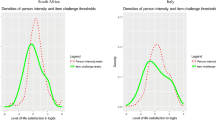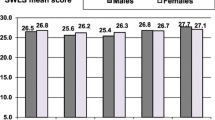Abstract
This study examined the psychometric properties of the Satisfaction with Life Scale (SWLS) in terms of internal consistency reliability, factorial validity, and measurement invariance across gender, age, residential region (metropolitan area/county town/rural area), educational level, and household income with a nationally representative sample of 4,795 participants in China. The percentages of male (47.0%) and female (53.0%) participants were about equal, and the mean age was 38.56 years (SD = 11.87). The results show that the SWLS has a high internal consistency reliability, a one-factor structure (with a wording effect on Items 4 and 5), strict invariance across gender, partial strict invariance across education (Items 1, 2 and 3), and partial strong invariance across age, income (Items 1, 2 and 3) and residential region (Items 1 and 2). The non-invariance of some items across age and region is discussed in terms of the rapid economic and social transitions of China in the past three decades.
Similar content being viewed by others
References
Arrindell, W. A., Heesink, J., & Feij, J. A. (1999). The satisfaction with life scale (SWLS): Appraisal with 1700 healthy young adults in The Netherlands. Personality and Individual Differences, 26, 815–826.
Atienza, F. L., Balaguer, I., & Garcia-Merita, M. L. (2003). Satisfaction with life scale: Analysis of factorial invariance across sexes. Personality and Individual Differences, 35, 1255–1260.
Beauducel, A., & Herzberg, P. Y. (2006). On the performance of maximum likelihood versus means and variance adjusted weighted least square estimation in confirmatory factor analysis. Structural Equation Modeling, 13, 186–203.
Busseri, M. A., Choma, B. L., & Sadava, S. W. (2009a). “As good as it gets” or “the best is yet to come”? How optimists and pessimists view their past, present, and anticipated future life satisfaction. Personality and Individual Differences, 47, 352–356.
Busseri, M. A., Choma, B. L., & Sadava, S. W. (2009b). Functional or fantasy? Examining the implications of subjective temporal perspective “trajectories” for life satisfaction. Personality and Social Psychology Bulletin, 35, 295–308.
Daniel, H., & Petter, G. J. (2008). A psychometric evaluation of the satisfaction with life scale in a Swedish nationwide sample of university students. Personality and Individual Differences, 44, 1070–1079.
Diener, E. (1984). Subjective well-being. Psychological Bulletin, 95, 542–575.
Diener, E., Emmons, R. A., Larsen, R. J., & Griffin, S. (1985). The satisfaction with life scale. Journal of Personality Assessment, 49, 71–75.
Diener, E., Suh, E. M., Lucas, R. E., & Smith, H. E. (1999). Subjective well-being: Three decades of progress. Psychological Bulletin, 125, 276–302.
Dolan, C. V. (1994). Factor analysis of variables with 2, 3, 5 and 7 response categories: A comparison of categorical variable estimators using simulated data. British Journal of Mathematical and Statistical Psychology, 47, 309–326.
Hu, L., & Bentler, P. M. (1999). Cutoff criteria for fit indexes in covariance structure analysis: Conventional criteria versus new alternatives. Structural Equation Modeling, 6, 1–55.
Kanbur, R., & Zhang, X. (2005). Fifty years of regional inequality in China: A journey through central planning, reform, and openness. Review of Development Economics, 9, 87–106.
Lu, L. (2001). Understanding happiness: A look into the Chinese folk psychology. Journal of Happiness Studies, 2, 407–432.
Lucas, R. E., Diener, E., & Suh, E. (1996). Discriminant validity of well-being measures. Journal of Personality and Social Psychology, 71, 616–628.
McDonald, R. P. (1999). Test theory: A unified treatment. Mahwah, NJ: Lawrence Erlbaum.
Muthén, B., & Kaplan, D. (1985). A comparison of some methodologies for the factor analysis of non-normal Likert variables. British Journal of Mathematical and Statistical Psychology, 38, 171–189.
Muthén, L. K., & Muthén, B. O. (2007). Mplus user’s guide (4th ed.). Los Angeles, CA: Muthén & Muthén.
Pavot, W., & Diener, E. (1993). Review of the satisfaction with life scale. Psychological Assessment, 5, 164–172.
Pavot, W., Diener, E., & Suh, E. (1998). The temporal satisfaction with life scale. Journal of Personality Assessment, 70, 340–354.
Pons, D., Atienza, F. L., Balaguer, I., & Garcia-Merita, M. L. (2000). Satisfaction with life scale: Analysis of factorial invariance for adolescents and elderly persons. Perceptual and Motor Skills, 91, 62–68.
Raju, N. S., Laffitte, L. J., & Byrne, B. M. (2002). Measurement equivalence: A comparison of methods based on confirmatory factor analysis and item response theory. Journal of Applied Psychology, 87(3), 517–529.
Sachs, J. (2003). Validation of the satisfaction with life scale in a sample of Hong Kong University students. Psychologia, 46, 225–234.
Shevlin, M. E., Brunsden, V., & Miles, J. N. V. (1998). Satisfaction with life scale: Analysis of factorial invariance, mean structures and reliability. Personality and Individual Differences, 25, 911–916.
Sicular, T., Yue, X., Gustafsson, B., & LI, S. (2007). The urban-rural income gap and inequality in China. Review of Income and Wealth, 53, 93–126.
Tang, S., Meng, Q., Chen, L., Bekedam, H., Evans, T., & Whitehead, M. (2008). Tackling the challenges to health equity in China. The Lancet, 372, 1493–1501.
The National Bureau of Statistics of China. (2008). China statistical yearbook 2008. Beijing: China statistics press.
Tucker, K. L., Ozer, D. J., Lyubomirsky, S., & Boehm, J. K. (2006). Testing for measurement invariance in the satisfaction with life scale: A comparison of Russians and North Americans. Social Indicators Research, 78, 341–360.
Vandenberg, R. J., & Lance, C. E. (2000). A review and synthesis of the measurement invariance literature: Suggestions, practices, and recommendations for organizational research. Organizational Research Methods, 3(1), 4–70.
Vassar, M. (2008). A note on the score reliability for the satisfaction with life scale: An RG study. Social Indicators Research, 86, 47–57.
Vitterso, J., Biswas-Diener, R., & Diener, E. (2005). The divergent meanings of life satisfaction: Item response modeling of the satisfaction with life scale in Greenland and Norway. Social Indicators Research, 74, 327–348.
Wu, C. H., Chen, L. H., & Tsai, Y. M. (2009). Longitudinal invariance analysis of the satisfaction with life scale. Personality and Individual Differences, 46, 396–401.
Wu, C. H., & Yao, G. (2006). Analysis of factorial invariance across gender in the Taiwan version of the satisfaction with life scale. Personality and Individual Differences, 40, 1259–1268.
Yao, G., & Wu, C. H. (2009). Similarities and differences among three Chinese versions of the WHOQOL-Questionnaire: Comparisons of Taiwan version to the China and Hong-Kong Versions. Social Indicators Research, 91, 79–98.
Zhang, X. B., & Kanbur, R. (2005). Spatial inequality in education and health care in China. China Economic Review, 16, 189–204.
Zumbo, B. D., Gadermann, A. M., & Zeisser, C. (2007). Ordinal versions of coefficients alpha and theta for Likert rating scales. Journal of Modern Applied Statistical Methods, 6, 21–29.
Acknowledgments
This study was supported in part by the Young Scientists Fund of the Institute of Psychology, Chinese Academy of Sciences (No. O8CX025002) and the Knowledge Innovation Project of the Chinese Academy of Sciences (No. KSCX2- YW-R-130; KKCX1-YW-05). The funders had no role in study design, data collection and analysis, decision to publish, or preparation of the manuscript.
Author information
Authors and Affiliations
Corresponding author
Rights and permissions
About this article
Cite this article
Bai, X., Wu, C., Zheng, R. et al. The Psychometric Evaluation of the Satisfaction with Life Scale Using a Nationally Representative Sample of China. J Happiness Stud 12, 183–197 (2011). https://doi.org/10.1007/s10902-010-9186-x
Published:
Issue Date:
DOI: https://doi.org/10.1007/s10902-010-9186-x




